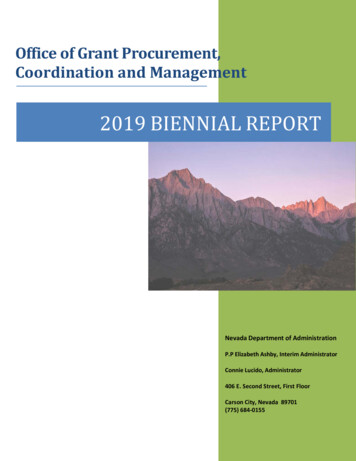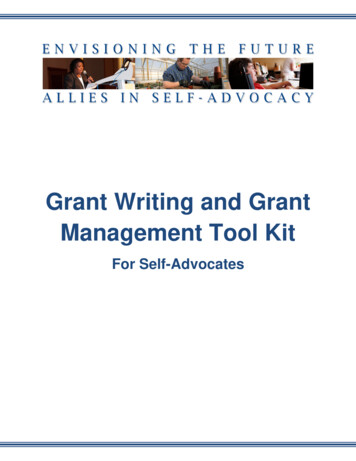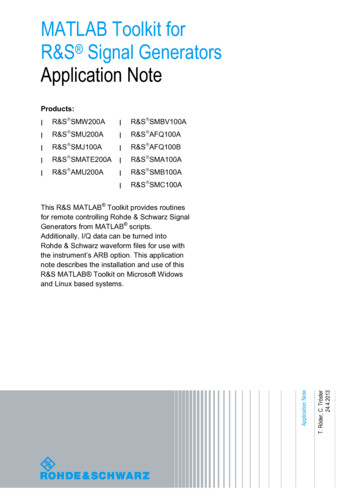
Transcription
Grant Writing Toolkit: The Program PlanWritten by: Judith Tamm and Tsiporah NepheshToolkits are designed to provide you with easy to access information on key subject areas thatcan strengthen your organization.We thank the Daniels Fund for providing funding for the development of these toolkits.Center for Nonprofit ExcellenceUnited Way of Central New Mexico2340 Alamo SE, #200, Albuquerque, NM 87106(505) enterfornonprofitexcellence.orgCNPE Toolkit-The Program Plan www.centerfornonprofitexcellence.org – July 14, 20101
The Program PlanOverviewPurpose of a Program PlanPlan in AdvanceQualities of Good Program PlansProgram Plan yConsiderationsAdditional ResourcesAbout the AuthorsOverview:In addition to securing funding, grant writing provides a vehicle for your organization to educatefunders about key community needs. A grant application can inform funders of how yourorganization meets those community needs. Funders and nonprofits that deliver communityprograms have a symbiotic relationship; both entities can benefit from that relationship.Grantmakers receive requests that far exceed the amount of funds they have available todistribute making the grant process extremely competitive.The United Way of Central New Mexico’s Center for Nonprofit Excellence has created toolkitsto assist with grant research and grant proposal writing. It is important to read all grantguidelines carefully and follow the application instructions. Each grant application or requestfor proposal uses its own terminology and has its own specific requirements. Below are somecommon grant application components.Grant Research- Although not part of a grant application, grant research is a critical part of the process.Research funders to ensure that your proposal fits within the grantmaker’s priorities. SeeResearching Grantmakers ToolkitCover Letter- Briefly identify your organization, describe the program plan (one or two sentences) andstate the dollar amount of the request. Include the name and contact information of theperson in your organization who will be the contact for the grant.Needs Assessment / Problem Statement / Needs Statement- Delineate the problem or issue within the community to be addressed, provide data tosubstantiate the need and a human interest story or example to make it personal. SeeNeeds Statement ToolkitGoals and Objectives- Generally, one section of the application requests information about what you willaccomplish and the steps to do so.CNPE Toolkit-The Program Plan www.centerfornonprofitexcellence.org – July 14, 20102
-Goals can be broad, used to define the overall purpose of the program.Objectives can be the measurable changes expected as a result of the program. Make theobjectives specific: who will benefit from the program, how many and in what time frame.- If there are several goals, relate objectives to the appropriate goal.Program Plan / Proposed Project / Project Design- Detailed information about your organization’s plans to address the community need,including who or what will benefit from the program, who will carry out the program andhow.Program Budget- Consider all the expenses to implement the program: salaries and benefits, supplies,transportation, technology, and administrative expenses.Evaluation- Describe plans to assess the program and measure impact.- Measurement tools may be data collection, client satisfaction surveys, or other tools.Include what is being measured and how often each tool is used.- With ongoing measurement and periodic evaluation, adjustments and changes can bemade to the program to improve the results.- Measurement and evaluation should relate to the objectives of the program plan andfunding request.Collaboration Information- Describe how your organization will work with other organizations to leverage resources.Other Funding / Sustainability- Identify other funding sources, including fee for service, and recent grants awarded,pending and declined.Qualifications / History / Organizational Background- In a brief history of the organization emphasize the accomplishments and expertise;describe your organization’s ability to do the work proposed; information requested mayinclude: mission statement; organizational goals; EIN number; summary of key personnelqualificationsAttachments / Appendices- May include: IRS letter of determination; letter from the New Mexico Attorney General;letter from Registrar of Charitable Organizations; most recent IRS 990; list of BoardMembers and affiliations; current Financial Statements; audited financial statements; AntiDiscrimination Policy; Letters of Support.Back to the topProgram plans are used to align the work of the organization with its mission; develop programs in an efficient, effective manner map out ideas for future growth of the organizationBack to the topPlan in AdvanceThe advantages of planning programs beyond grant writing:CNPE Toolkit-The Program Plan www.centerfornonprofitexcellence.org – July 14, 20103
Not restricted by the parameters of the grantTake as much time as needed to develop ideas with input from key personnelPlan for the growth of the organization in a comprehensive wayWhen it comes time to write a grant proposal, the plan just needs to be shaped andformatted to fit the guidelines and the budget updated to reflect current market valuesBack to the topQualities of Good Program Plans Align with organization’s mission Innovative Expressed with enthusiasm Clearly state the plan of action, who will benefit, time frame and cost Budget matches plan Includes plan for continuing past grant period Description of the lasting benefits of the program Description of why your organization is perfectly poised to address the identified needBack to the topProgram Plan QuestionsIn preparation for designing a program plan consider the following questions. Developing theanswers will shape the program plan. Here are groups of questions to consider:Need:What is the issue or problem to be addressed?(See the Needs Statement Toolkit for more information.)Program:What is the plan to address the problem or issue?Who will benefit?What activities will be implemented?How will the plan be carried out?Who will the program serve?Who will do the work?Do the staff/volunteers who will carry out the proposed work need training?Budget:How much will it cost to implement the program?How much staff or volunteer time will it take?Will additional help be required? Volunteer? Contract? New Staff?What supplies or equipment will be needed?Where will the project take place?Is it necessary to rent, buy or borrow facilities?Is travel involved? (Factor in mileage; car rental; hotel; meals.)Is specialized training needed?CNPE Toolkit-The Program Plan www.centerfornonprofitexcellence.org – July 14, 20104
What is the cost per service or per client? (e.g., 5,320 can provide counseling services for ayear for an entire family dealing with grief)Outcome:What is the benefit to the client?What is the benefit to the community?What is the benefit to the funder?Why will the proposed project make a difference?Goal:What major accomplishments must be reached to attain each outcome?Is it measurable?Does it have quantitative and qualitative measurements built in?Objectives:What very specific actions need to be undertaken to fulfill the program goal?Measurement and Evaluation:How will progress be measured?How many can be served in what time period?Does the plan include both quantitative and qualitative measures?Is it realistic—achievable?Capacity and Capability:Does your organization have the ability to do the program and manage the grant funds?What makes your organization qualified to undertake this program?Why should your organization address this issue?Why now?Who else is doing similar work?Is it possible to partner with another group or organization?Future Sustainability:How will the program be sustained once the grant is over?Check the Feasibility:Does this program align with the organization’s mission?How does this program complement the organization’s existing programs?Can your organization actually carry out the proposed program?Does the program further the mission of your organization?Is the program tied in with your organization’s strategic plan?Back to the topClarity Is the information requested in the grant guidelines easy to find in your grant proposal?Use the funders’ language for consistency. Is the information presented in the same order as requested in the guidelines?CNPE Toolkit-The Program Plan www.centerfornonprofitexcellence.org – July 14, 20105
Reviewers read through hundreds of proposals, make yours easy to follow.Keep it short and to the point; cut out anything that is not relevant.Back to the topReadability Does your program plan flow logically from statement of problem to proposed solution? Does the information flow logically? Can anyone understand it or has it been written with technical language and acronyms? Has it been reviewed for spelling and grammatical errors? Get someone who has not worked on the proposal to read it.Back to the topAchievability Is the program plan realistic? Can it be achieved within the time frame stated and with the resources available? What is the back-up plan if you don’t receive funding or if you don’t receive as much asrequested?Back to the topSpecificity Be explicit about– Who the program will serve– Why this is a good approach– Why your organization– Why this is cost effective– How much funding you are requesting– What the lasting benefits will be for the clients– What the lasting benefits will be for the communityBack to the topConsiderations The people reviewing your proposal may not know anything about your organization, theissues, or your community. Funders like to see collaboration; it can be an efficient way to maximize resources. Is thisfeasible for what you are proposing? Funders like to see a diversity of resources. What other sources of income does yourorganization have and how are you developing them? Funders sometimes read through hundreds of applications. Use enthusiasm and dynamiclanguage to stand out.Back to the topCNPE Toolkit-The Program Plan www.centerfornonprofitexcellence.org – July 14, 20106
Additional ResourcesAdvice and Information on Grant Seeking and Proposal WritingOverview of Non-Profit Program Planning by Carter McNamara, rogplan.htmlGrant-writing tools for non-profit organizationsNon-profit guideshttp://www.npguides.org/Grant writing tools, including samplesProgram Planning & Development – Program Logic ModelUniversity of Missouri amdev/plm/Explains how to use a logic model as part of program plan development.Program Planning and ManagementFree Management Libraryhttp://www.managementhelp.org/prog mng/prog mng.htmIncludes several articles, including basic guidelines.Program Planning FactsIowa State University, University ions/EDC118.pdfBasic steps of program planning clearly laid out.Back to the topAbout the Authors:Judith TammJudith Tamm is the Executive Director, Taos Housing Corporation. She has worked forgovernments, nonprofits, and for herself. Working as a fundraiser for the past 10 years, shehas raised more than 8.5 million to support projects ranging from construction of municipalwater lines, street paving, programs for people with severe disabilities, and community andeconomic development.Tsiporah NepheshTsiporah Nephesh is the Program Coordinator, Center for Nonprofit Excellence, a program ofUnited Way in partnership with the Albuquerque Community Foundation. Her previousnonprofit experience includes serving as the Executive Director, North American College ofBotanical Medicine in Albuquerque, and Executive Director, the Regina Modern Dance WorksSchool in Regina, Saskatchewan.Back to the topCNPE Toolkit-The Program Plan www.centerfornonprofitexcellence.org – July 14, 20107
to assist with grant research and grant proposal writing. It is important to read all grant guidelines carefully and follow the application instructions. Each grant application or request for proposal uses its own terminology and has its own specific requirements. Below are some common grant application components. Grant Research










